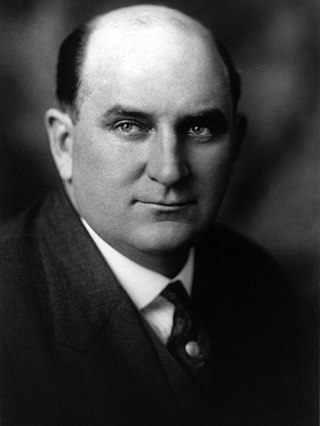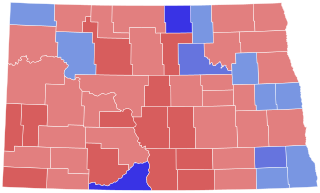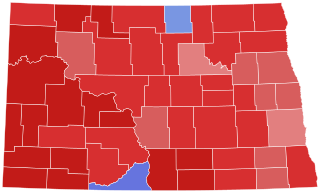
Lynn Joseph Frazier was an American educator and politician who served as the 12th governor of North Dakota from 1917 until being recalled in 1921 and later served as a U.S. Senator from North Dakota from 1923 to 1941. He was the first American governor ever successfully recalled from office. The only other American governor to ever be recalled is Gray Davis, who was recalled in 2003.

United States gubernatorial elections were held on November 2, 2004, in 11 states and two territories. There was no net gain in seats for either party, as Democrats picked up an open seat in Montana while defeating incumbent Craig Benson in New Hampshire, while Republicans defeated incumbent Joe Kernan in Indiana and won Missouri after Bob Holden lost in the primary. These elections coincided with the presidential election.

Edward Thomas Schafer is an American businessman and politician who served as the 30th governor of North Dakota from 1992 to 2000 and as the 29th United States secretary of agriculture from 2008 to 2009 under President George W. Bush. From January to July 2016 he served as interim president of the University of North Dakota.

United States gubernatorial elections were held in four states. Kentucky and Mississippi held their general elections on November 4. Louisiana held the first round of its jungle primary on October 4 and the runoff on November 15. In addition, California held a recall election on October 7.

United States gubernatorial elections were held on November 7, 2000, in 11 states and two territories. The elections coincided with the presidential election. Democrats gained one seat by defeating an incumbent in West Virginia. As of 2024, this remains the last gubernatorial cycle in which a Democrat won in Indiana.

The 2008 North Dakota gubernatorial election took place on 4 November 2008 for the post of Governor of North Dakota. Incumbent Republican governor John Hoeven was easily reelected again, defeating Democratic-NPL challenger Tim Mathern. The primaries took place on June 10, 2008. John Hoeven outperformed John McCain, the Republican presidential nominee, by about 21%. McCain defeated Democratic nominee Barack Obama 53%–45% in the concurrent presidential election.

The 1996 United States elections were held on November 5, 1996. Democratic President Bill Clinton won re-election, while the Republicans maintained their majorities in both houses of the United States Congress.

The 2000 North Dakota gubernatorial election took place on November 7, 2000 for the post of Governor of North Dakota. Incumbent Republican governor Ed Schafer decided not to run for reelection. Republican nominee John Hoeven won the election over Democratic State Attorney General Heidi Heitkamp. Heitkamp had led in the polls until early October, when reports indicated that she had breast cancer, and would undergo surgery. She ran advertisements to assure voters she was still fit to serve; however, by the final month, Hoeven had taken a six-point lead in polling. As of 2021, this is the most recent North Dakota gubernatorial election in which the Democratic nominee received over 40% of the vote. Hoeven and Heitkamp later served alongside each other in the United States Senate from 2013 to 2019.

The 2012 North Dakota gubernatorial election was held on November 6, 2012, to elect a Governor and Lieutenant Governor of North Dakota, concurrently with the 2012 U.S. presidential election, as well as elections to the United States Senate, elections to the United States House of Representatives and various state and local elections. Incumbent Governor Jack Dalrymple succeeded to the office when then-Governor John Hoeven resigned to take a seat in the U.S. Senate in 2010. Dalrymple, a member of the Republican Party, won election to a full term. Ryan Taylor was the Democratic nominee. Dalrymple prevailed with 63% of the vote; he declined to seek re-election in 2016.

The 1968 United States elections were held on November 5, and elected members of the 91st United States Congress. The election took place during the Vietnam War, in the same year as the Tet Offensive, the assassination of Martin Luther King, Jr., the assassination of Robert F. Kennedy, and the protests of 1968. The Republican Party won control of the presidency, and picked up seats in the House and Senate, although the Democratic Party retained control of Congress.

The 1988 North Dakota gubernatorial election took place on November 8, 1988 to elect the governor of North Dakota. Incumbent Democratic governor George A. Sinner was reelected to a second term with 58% of the vote, defeating Republican nominee Leon Mallberg, a businessman and "anti-tax crusader" and his running mate Donna Nalewaja. Lloyd Omdahl, who had been appointed Lieutenant Governor of North Dakota in 1987 after the death of Ruth Meiers, was elected on the ticket. As of 2024, this was the last time a Democrat was elected Governor of North Dakota.

The 1992 North Dakota gubernatorial election took place on 3 November 1992. Incumbent Democratic-NPL Governor George A. Sinner retired. Republican nominee Ed Schafer defeated Democratic former Attorney General of North Dakota Nicholas Spaeth in a landslide.

The 1974 South Dakota gubernatorial election was held on November 5, 1974, to elect a Governor of South Dakota. This election was the first in South Dakota to elect the governor for a four-year term, after it was allowed by a constitutional amendment passed in 1972. Democratic nominee and Governor Richard F. Kneip was re-elected, defeating Republican nominee John E. Olson. As of 2024, this is the last time that a Democrat was elected Governor of South Dakota, marking the start of the longest Republican winning streak in the country for a state's governorship, as well as the longest gubernatorial winning streak by a single party.

The 2016 North Dakota gubernatorial election was held on November 8, 2016, to elect the Governor and Lieutenant Governor of North Dakota, concurrently with the 2016 U.S. presidential election, as well as elections to the United States Senate, elections to the United States House of Representatives and various state and local elections. This would have been the first time North Dakotans selected a governor under new voter ID requirements, in which a student ID was insufficient identification to vote, but a court ruling in August 2016 struck the down the provision; the election was held under the 2013 rules.

The 2020 North Dakota gubernatorial election was held on November 3, 2020, to elect the governor and lieutenant governor of North Dakota, concurrently with other federal and statewide elections, including the U.S. presidential election. Incumbent Republican governor Doug Burgum and lieutenant governor Brent Sanford were both re-elected to a second term.

Kelly Michael Armstrong is an American lawyer and politician serving as the U.S. representative for North Dakota's at-large congressional district since 2019. A member of the Republican Party, he served as the North Dakota state senator from the 36th district from 2012 to 2018 and chair of the North Dakota Republican Party from 2015 until 2018. On January 23, 2024, he announced he would not seek re-election to the House, and would instead run in the 2024 North Dakota gubernatorial election. Armstrong won the Republican primary on June 11, 2024, and defeated Democratic nominee Merrill Piepkorn in the general election.

United States gubernatorial elections were held in 1921, in two states.
Michelle Strinden is an American politician serving as a member of the North Dakota House of Representatives from the 41st district. Elected in November 2018, she assumed office on December 1, 2018. She is the lieutenant governor-elect of North Dakota, having been elected in 2024, on a ticket with U.S. Representative Kelly Armstrong, the candidate for governor.

The 2024 North Dakota gubernatorial election was held on November 5, 2024, to elect the governor of North Dakota. Incumbent Republican governor Doug Burgum decided to not seek re-election to a third term. He would ultimately decide to run for president. The Democratic–Nonpartisan League (NPL) Party has not won a governor's race in North Dakota since 1988.

United States gubernatorial elections were held on November 5, 2024, in 11 states and two territories. The previous gubernatorial elections for this group of states took place in 2020, except in New Hampshire and Vermont, where governors only serve two-year terms and elected their governors in 2022. In addition to state gubernatorial elections, the territories of American Samoa and Puerto Rico held elections for their governors. This was also the first time since 1988 that a Republican nominee won the gubernatorial election in American Samoa and also the first time since 1996 that an incumbent governor there lost re-election.






















